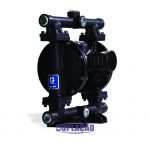Pneumatic diaphragm pumps are extremely versatile, easy to operate and have low maintenance costs. However, depending on the fluid being transported and the temperature of that component. These pumps may end up freezing during their activity, which can cause numerous problems for the company.
This freezing caused by the accumulation of ice causes the obstruction of the exhaust system, which can impair its full functioning and even cause unexpected stops. For industries that depend on the productivity of their equipment, this problem can be extremely harmful.
The good news is that this problem can be avoided and your production can maintain its full functionality.
What to do in cases of frostbite?
The first step is to identify whether the problem your pump is causing is actually freezing. For this, it is important to check some aspects, such as:
If your pump pressure fluctuations are erratic;
If its operation is interrupted, but is resumed after defrosting;
If the process is taking longer than usual;
If to the touch the engine is presenting a low temperature;
If there is presence of moisture in the compressed air being used for pump operation;
If to maintain a constant cycle rate, you need to make adjustments to the air supply or flow control.
Having identified the problem, we need to understand what can cause the pneumatic diaphragm pumps to freeze. As compressed air passes through your pneumatic pump, it expands and its temperature can drop very quickly. This process is more common when using pumps that work with high discharge pressures.
The result of this process is supersaturated air, which happens when cold air contains more moisture than it can hold. This supersaturated air, when in contact with a cold surface, such as the structure of the pump, can result in the formation of ice at the points of impact.
These points create a favorable environment for the accumulation of small ice particles. With this, we can understand that this accumulation of ice is directly related to the temperature of the surface and the points of impact where it can accumulate.
Surfaces that are directly facing the compressed air inlet are usually colder, favoring freezing inside your pump.

First steps to prevent freezing inside your equipment
The first step is to install a dryer on your air compressor so that the air used is always clean and dry. Removal of the muffler can also be done, as ice tends to accumulate more often on these components. However, although it solves the freezing problem, the pump will start to emit a higher noise, which can impair the operation and the quality in the working environment.
More viscous fluids require a more intensive functionality of the pneumatic diaphragm pump, so ice can accumulate more easily. The higher the inlet pressure of your pump, the lower the exhaust temperature. This means that, as your Focusing on your flow curve is closer to maximum capacity, the lower the temperature and the greater the likelihood of freezing.
Other causes for pump freezing
In addition to this factor, it is important to consider that there are other reasons that can lead to equipment freezing, such as:
The volume of supplemental air is too high for the application performed;
Long duty cycle;
Cooler climate in the environment;
Presence of moisture in the compressed air used or poor quality area;
Lack of drying equipment;
Pumping of high viscosity fluids.
How to prevent icing problems on your pneumatic diaphragm pump?
Here are some tips that we have separated so that you can combat this problem in your industry:
Use a plastic silencer instead of a metal solution. Plastic, being less conductive, cannot get as cold as metal.
Use a larger muffler with a larger surface area. Even if the air is at a low temperature, the time required for freezing will be longer.
Remove moisture from compressed air using a dryer. It is possible to remove moisture from compressed air and prevent it from turning to ice during pumping.
Use a lower speed, as the higher the speed, the greater the chance of freezing on the inside of the pump;
Reduce your muffler's conductivity by using an extension hose. With this, it is possible to increase the surface area and reduce the conductivity.
Perform frequent cleaning of the muffler;
Use correct inlet and outlet port sizes so that excessive pressure is not created. If using a pump below its full capacity, it may be necessary to use a larger size so that it is not necessary to demand maximum functionality. That way, she can get the lowest speed and reduce the chance of freezing.
Try to use a damper plate with a heat sink;
Seek to establish an escape path with fewer curves to reduce points of impact.
Direct cold air output directly to the muffler to reduce contact in impact zones and consequently, ice formation.
These tips can help reduce the incidence of ice inside your pump and the problems that come with it. If you need help, contact a Duplication specialist and we will provide the best service to help you solve the problem.










